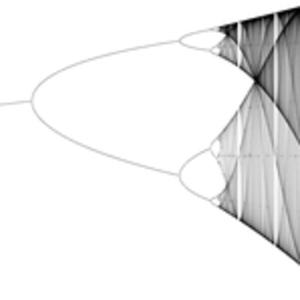-
-
Welcome and Course Overview
-
How to Take this Course
-
Introduction to Functions
-
Iteration
-
Fixed Points and Stability
-
Summary
-
Homework (Optional)
-
Homework Solutions (Optional)
-
Test
-
-
-
Introduction
-
The Idea of the Derivative
-
Differential Equations
-
Computational Solutions
-
Qualitative Solutions
-
Summary
-
Newton, Laplace, and Determinism
-
Homework (Optional)
-
Test
-
-
-
Introducing the Logistic Equation
-
Iterating the Logistic Equation
-
The Butterfly Effect
-
Randomness?
-
Modeling Styles
-
Lyapunov Exponents (Optional)
-
Logistic Equation Programs
-
Summary
-
Homework (Optional)
-
Test
-
-
-
The Logistic Differential Equation
-
Logistic Equation with Harvest
-
Bifurcation Diagrams
-
Bifurcations
-
Hysteresis (Optional)
-
Summary
-
Homework (Optional)
-
Test
-
-
-
Final State Diagrams
-
The Bifurcation Diagram
-
Bifurcation Diagram Explorations
-
Logistic Equation Programs
-
Summary
-
Homework (Optional)
-
Test
-
-
-
Introduction
-
Universality in Maps
-
Universality in Physical Systems
-
Renormalization
-
Summary
-
Bifurcation Diagram Programs
-
Homework (Optional)
-
Further Reading (Optional)
-
Test
-
-
-
Lotka Volterra Differential Equations
-
The Phase Plane
-
The Hénon Map
-
The Lorenz Equations
-
Summary
-
Hénon Map Program
-
Homework (Optional)
-
Test
-
Further Reading (Optional)
-
-
-
The Hénon Attractor
-
The Lorenz Attractor
-
Stretching and Folding
-
Links to Programs
-
Summary
-
Homework (Optional)
-
Test
-
-
-
Diffusion
-
Reaction-Diffusion Equations
-
Computer Experiments
-
Real Experiments
-
Summary
-
Links to Programs
-
Additional Resources (Optional)
-
No Homework for Unit 9
-
No Test for Unit 9
-
-
-
Summary and Overview
-
Interview: Stephen H. Kellert
-
Interview: Stephen W. Morris
-
Themes and Conclusions
-
Farewell
-
9.7 Additional Resources (Optional) » Additional Resources
Reaction-diffusion Systems. This is a fairly advanced topic. I find that the math and chemistry can get pretty complex.
-
Edelstein-Keshet, Leah. Mathematical models in biology. Vol. 46. Siam, 1988. This is a fantastic book. It is an exceptionally clear and well-written introduction to a range of topics. In addition to nice coverage of reaction-diffusion systems and pattern formation, it include finite difference equations (i.e., iterated function) and ordinary differential equations. Highly recommended.
-
Britton, Nicholas F. Essential mathematical biology. Springer, 2003. A clear introductory survey of a topics in mathematical biology.
-
Murray, James D. Mathematical Biology I: An Introduction, Springer. 2007. A comprehensive treatment of mathematical biology at a fairly advanced level. In my opinion less accessible than the above two references.
Belousov-Zhabotinsky Reactions.
- Links to the two videos are here and here. These videos were posted by Professor Stephen Morris. Check out his youtube channel and flickr stream for many more pictures and videos of pattern-forming systems.
- The scholarpedia entry on the Belousov-Zhabotinsky reaction looks like a good place to start for more techincal detals.
General Pattern Formation.
The three books by Philip Ball are a fantatsic introduction to shapes and patterns in physical and natural systems. Clear and interesting, with a minimum of mathematics.
-
Ball, Philip. Shapes: nature's patterns: a tapestry in three parts. Vol. 1. Oxford University Press, 2011.
-
Ball, Philip. Flow: nature's patterns: a tapestry in three parts. Vol. 2. Oxford University Press, 2011.
-
Ball, Philip. Branches: nature's patterns: a tapestry in three parts. Vol. 3. Oxford University Press, 2011.
Other books on pattern formation include:
-
Adam, John A. Mathematics in nature: Modeling patterns in the natural world. Princeton university press, 2006. An engaging account of an eclectic set ot topics, including several examples of pattern formation. Most of the book assumes a knowlege of calculus.
